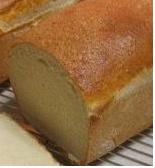Manchet

Manchet loaf
|
|
| Type | Sweet bread |
|---|---|
| Place of origin | Britain |
| Main ingredients | Flour |
| Variations | Bath bun, Sally Lunn bun |
| |
|
Manchet, manchette or michette (French), is a wheaten yeast bread of very good quality, or a small flat circular loaf of same. It was a bread that was small enough to be held in the hand or glove (see also manchette).
One of the first recipes printed in English for manchet breads comes from 1588 and the recipe book The Good Huswifes Handmaide by an unknown author. In it the author explains that the flour must be fine and have been "boulted" twice.
There are several recipes for manchets mentioned in Florence White's classic English cuisine book Good Things in England first published in 1932. She gives five regional varieties of the bread and quotes from sources for the recipes. The first is from Gervase Markham in Nottinghamshire published in 1615 where White quotes an anonymous source that describes a manchet as 'Your best and principal bread'.
There is also a reference to "Manchetts for the Queen's Maides", a royal ordinance originating from Eltham Palace in 1526 during Henry VIII's reign which describes a menu for medieval aristocracy. It is inserted because a correspondent had requested when manchets were to be served at court. This suggests that in origin it was a luxurious bread containing ingredients that were available only to the wealthy. The most superior wheat for a manchet was said to come from Heston, near Hounslow during the reign of Elizabeth I. Manchets would sometimes be sweetened by the addition of scented ingredients such as rose water, nutmeg and cinnamon.
Breakfast in the household of Henry Percy, 9th Earl of Northumberland, according to the household accounts from 1564 to 1632, for the earl and his lady on a flesh day was a loofe of bred in trenchors, 2 manchets, 1 quart bere, 1 quart wyne, a Chyne of Muton or Chyne of Beef Boilid; the two older sons had "'2 loaf of household Breid, a Manchet, 1 Potell [two quarts] of Bere, a Chekynge [chicken] or ells 3 mutton Bonys boyled.
Florence White makes reference to three contemporary versions. The Cornish manchant which she confirms is shaped by hand, a version from the Isle of Wight and a recipe from 1676 from Sussex for Lady Arundel's Manchet which is notable for the use of cream and milk in the constituents similar to brioche. The latter version she updates.
...
Wikipedia
